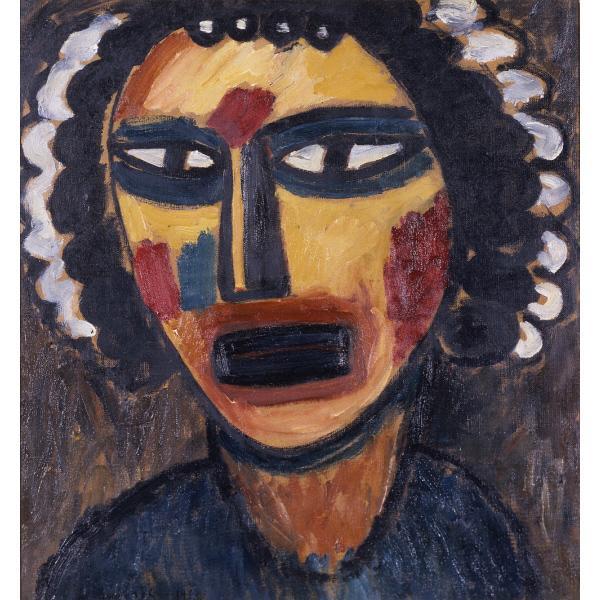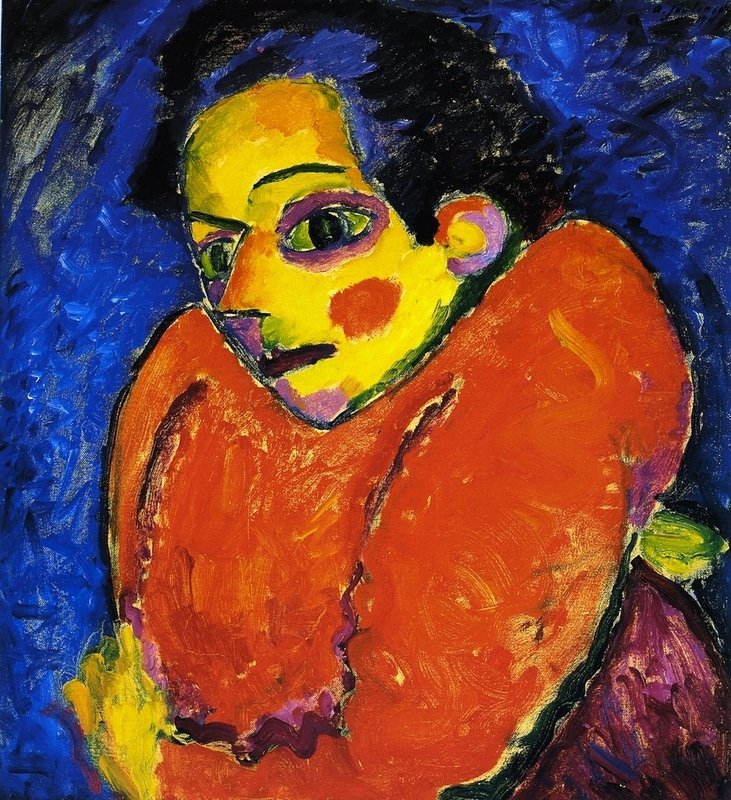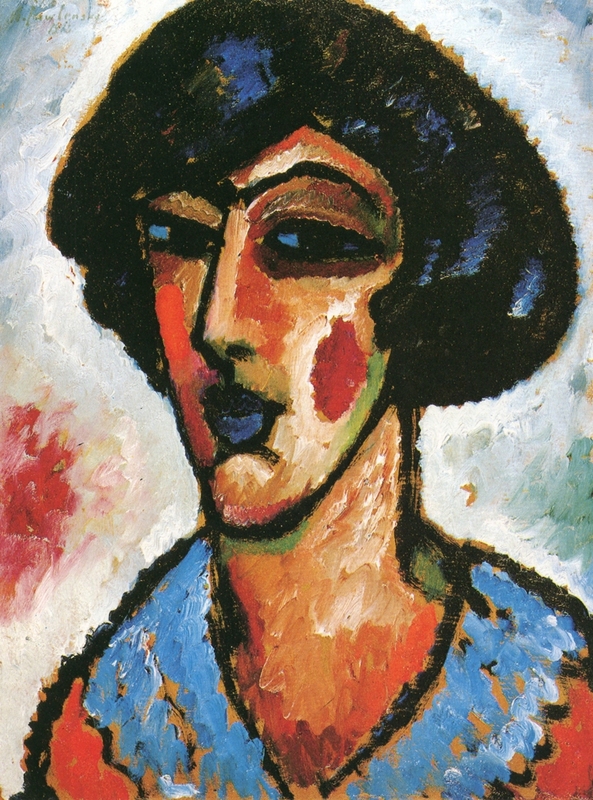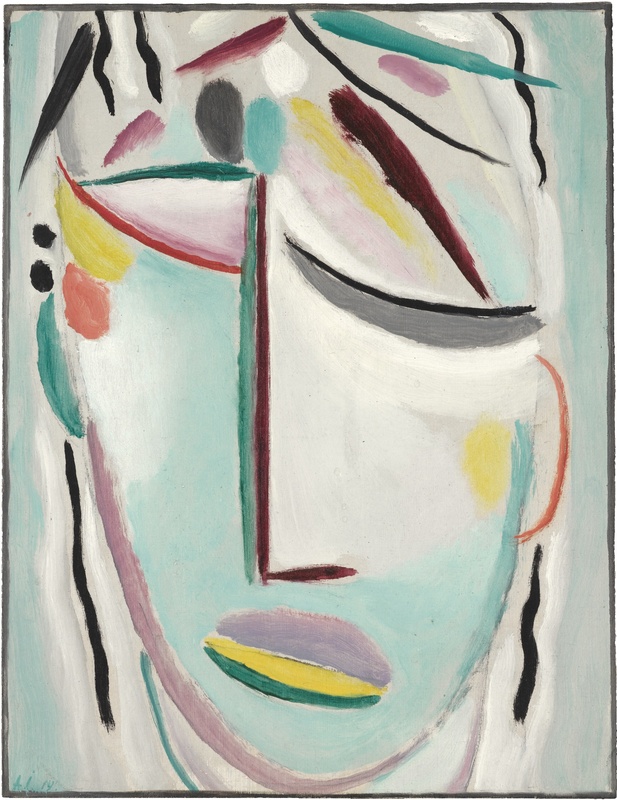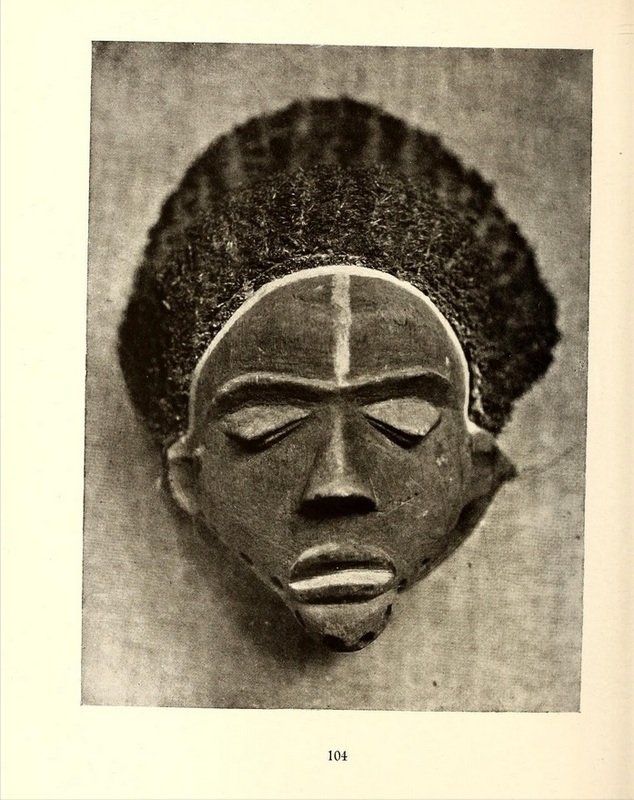Alexei von Jawlenski: Prophet (Sybil)
Alexei von Jawlensky's Prophet (Sybil) (Figure. 3) is a painting of a highly stylized and mask-like face rendered in strong yellows, blacks, and reds. Painted in 1913 while the artist was a member of The Blue Rider, this work exemplifies Jawlensky's exploration into thick application of paint and expressive use of color. Jawlensky primarily painted faces or heads and was interested in exploring the psychological and mystical aspects of his portraiture (Note 6). He often painted his faces very close to the viewer in order to enhance this effect. Prophet (Sybil) consumes the space and looms out at the viewer. The thick black and blue lines depicting hair rest lightly on the edge of the canvas, adding tension and bringing the face close to confront the viewer. The face itself is strongly influenced by African masks with huge almond shaped eyes, a long straight nose, and a gaping rectangular mouth. The flattened features present a single plane and the cropping draws the face directly to the viewer. The immediacy of the piece demands attention while the primitivist style projects an ancient and powerful aura.
Prior to this work, Jawlensky experimented with using color as a method for exploring psychological aspects of human portraiture. However, his earlier works were not as abstracted and mask-like. Jawlensky's 1911 painting Hunchback (Figure 4) uses thick brushstrokes and vivid colors similar to what we see in Prophet (Sybil). However, his rendering of the face has more of a suggestion of depth and the portrait is not as tightly framed and claustrophobic, although it remains close (Note 7). Jawlensky painted Sicilian Woman (Figure 5) in the same year as Prophet and the stylistic shifts he made in between 1911 and 1913 are evident in his treatment of the unspecified Sicilian woman's face. This portrait is much flatter than Hunchback and while the cropping is closer it's not as immediate as Prophet. Sicilian Woman has a very light background and more restrained use of colors than Prophet. However, Jawlenski's use thick splotches of red and white and minor use of green shadows in Sicilian Woman are still very much abstracted. Jawlensky's use of mask-like features in portraits also clearly progressed from Hunchback to Sicilian Woman. Hunchback's face has a realistic shape and has close to realistic proportions. The woman's eyes are abstracted and large and she has a sharp triangular nose projecting over her cheek while her mouth is small and reserved. In contrast, Sicilian Woman's face is impossibly stretched and vertical with a long, strong nose and tightly pursed lips.
Although there is a stylistic progression in the two years between Hunchback and Sicilian Woman, Prophet (Sybil) shows an acceleration in experimentation when compared to the preceding works. In contrast to the other two works, the features of Prophet are so abstracted that they could not possibly be referencing individual features of a particular face. While the other two works have subtle and even pleasant backgrounds the dark, muddy background of Prophet ties the painting to the earth. Prophet's overtly mask-like features communicate an ancient, powerful presence. This ties strongly with Jawlenski's title which refers to the Sibyl, women in ancient Greece supposedly endowed with prophetic powers as oracles for the gods. The power of Prophet's expression stands in powerful contrast to both Hunchback and Sicilian Woman whose expressions read as absent and bemused, respectively. Prophet is highly abstracted but the facial expression is austere and direct. The eyes stare at the viewer with square, goat-like pupils rather than looking away or sideways. In spite of any distinctive facial features being abstracted away, Prophet remains confrontational and fierce.
In 1914, only a year after Jawlensky painted Prophet and Sicilian Woman, The Blue Rider disbanded due to the outbreak of WWI. This forced Jawlensky out of Germany and into neutral Switzerland to avoid conflict for a number of years. When compared to Jawlensky's post-war works, Prophet seems remarkably cohesive. Jawlensky's later works are characterized by a looser composition in which he breaks forms down into simple clean lines and dashes of colors. Jawlensky's 1919 piece Savior's Face: Martyr (Figure 6) contrasts with Prophet's thick and dark strokes by the use of long, thin strokes of color to delineate features. Jawlensky's earlier work uses wide strokes of deep colors to create a thick atmosphere whereas Martyr uses thin washes of paint and delicate lines of brighter colors to create a light and airy atmosphere. Jawlensky brings the face in Martyr even closer to the viewer than in Prophet and abstracts it further. However, the fact that the later work's eyes are closed in a melancholy expression make it inherently less confrontational and more introspective than Prophet.
Prophet is distinguished from Jawlensky's earlier works by its flattened and mask-like features and from his later works by its dense atmosphere and direct engagement with the viewer. Prophet confronts the viewer with stern and direct eye contact from an ageless and timeless face. The simple and stylized features evoke references to Western stereotypes of non-Western mystics and rituals which fascinated modernist painters. Jawlensky's portrait manages to be psychological in spite of its impersonal and non-specific features due to his use of darker and muddled colors. Jawlensky's exploration of direct engagement between subject and viewer pairs with the formal elements of his work to evoke a sense of mystery and power emanating from the enigmatic figure.

